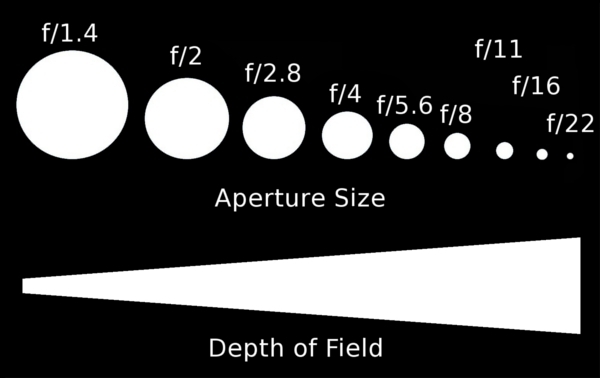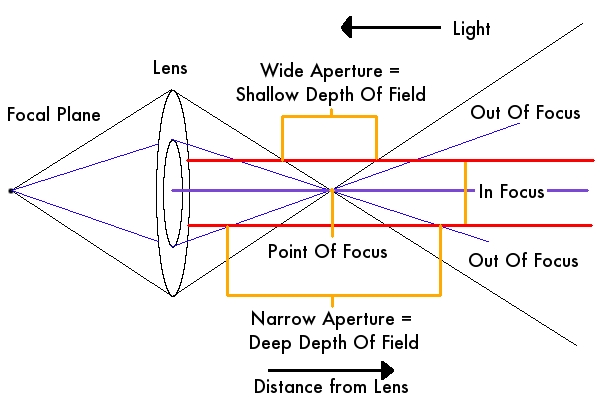FAQ: Understanding Depth of Field
This topic is locked to prevent further replies.
Jun 11, 2012 12:27:00 #
Original article here: http://www.expertphotography.com/understanding-depth-of-field
Why Depth of Field is important to your Photos
Depth of Field has positive and negative effects on your photos and knowing exactly what it does, and how to control it, is essential to taking the best possible photos. This post teaches you all about how to use it to your advantage and how much DoF is right for different situations.
What is Depth of Field?
Depth of Field (DoF) is the distance between the closest objects in focus and the furthest point of focus. The distance can be increased or decreased by changing the aperture of the lens. Youll often see shallow DoF used creatively in photos as it forces the focus onto a certain part of the photo.
How does it work?
DoF is controlled by the width of the aperture in the lens. For those of you that dont understand aperture, I strongly suggest you go back and read this post first: http://www.expertphotography.com/how-to-understand-aperture-5-simple-steps . The wider the aperture, the more shallow the DoF, and the smaller the aperture, the deeper the DoF. Have a look at the diagram below that explains this.
To really get a strong sense of why this is, have a look at the diagram below. The wide aperture, which goes from the full width of the lens, takes in the light at a much wider angle; this in turn means that the light has less further to go to get out of focus. A narrow aperture, on the other hand, stays in focus much longer as the light has further to travel to get out of focus.
Thats not all that affects DoF though, theres also the focal length and distance from subject.
Distance from Subject
The best way to demonstrate this is not with a diagram, but with your own hand. Take your arm and stretch it out in front of your face with your hand as far as you can reach. Looking at your hand youll notice that you can still work out a lot of detail behind it without moving your eyes away. Now, gradually move your hand closer to your face all the time focusing on it and youll notice that your peripheral vision will get more and more out of focus. The same effect is present when using a camera lens.
Creative uses of DoF
Shallow DoF is often used to create a point of focus on one single subject in a photo. Its hugely effective at doing this and has become quite common with the availability of cheap wide aperture lenses. I recommend playing around with shallow DoFs but be careful not to overdo it as your photos will start to become boring and similar. Its an easy effect to achieve, but that means so a lot of people will be doing it. It can be very effective, but try to go further then this to put yourself above the rest.
Extremely shallow DoF shot at f/1.4
Using an aperture this wide creates really nice, soft photos, and when shooting in the evening sun, it makes the photos look a lot warmer. Notice how the face is sharp, but the neck and shoulders are quite soft. Its also fun to play around with the focal plane when the DoF is this shallow; in this photo I placed the flower to the right of her face so that it was also in focus. I was able to achieve this easily as I wasnt too close to the subject, and the lens I used was only about 50mm.
Shallow DoF shot at f/1.8
This shot was taken in the evening as the sun was nearly gone, which is part of the reason the DoF was set so low. Its a really good way of getting smooth, soft photos, where there is still a point of sharpness and detail. Because the focal length was effectively about 75mm and I was very close to the object, the DoF was exaggerated.
Medium DoF shot at f/5.6
With an aperture of f/5.6, you can clearly make out the detail of the whole body, as well as some of the background. In situations like this where there is depth to the photo, its important to consider the aperture before taking the photo as youll want to keep as much of the subject in focus as possible.
Deep DoF shot at f/22
For many scene shots, youre going to want to keep as much of the scene in focus as possible. This means using a narrow aperture and a deep DoF which allows the viewers eyes to make their way round the whole photo and explore it. I chose this photo as an example as you can clearly see that theres a lot of depth to it and plenty of places for your eyes to wander.
For DoF examples mentioned above, see: http://www.expertphotography.com/understanding-depth-of-field
A more in-depth tutorial on DoF can be found here: http://www.cambridgeincolour.com/tutorials/depth-of-field.htm
Why Depth of Field is important to your Photos
Depth of Field has positive and negative effects on your photos and knowing exactly what it does, and how to control it, is essential to taking the best possible photos. This post teaches you all about how to use it to your advantage and how much DoF is right for different situations.
What is Depth of Field?
Depth of Field (DoF) is the distance between the closest objects in focus and the furthest point of focus. The distance can be increased or decreased by changing the aperture of the lens. Youll often see shallow DoF used creatively in photos as it forces the focus onto a certain part of the photo.
How does it work?
DoF is controlled by the width of the aperture in the lens. For those of you that dont understand aperture, I strongly suggest you go back and read this post first: http://www.expertphotography.com/how-to-understand-aperture-5-simple-steps . The wider the aperture, the more shallow the DoF, and the smaller the aperture, the deeper the DoF. Have a look at the diagram below that explains this.
To really get a strong sense of why this is, have a look at the diagram below. The wide aperture, which goes from the full width of the lens, takes in the light at a much wider angle; this in turn means that the light has less further to go to get out of focus. A narrow aperture, on the other hand, stays in focus much longer as the light has further to travel to get out of focus.
Thats not all that affects DoF though, theres also the focal length and distance from subject.
Distance from Subject
The best way to demonstrate this is not with a diagram, but with your own hand. Take your arm and stretch it out in front of your face with your hand as far as you can reach. Looking at your hand youll notice that you can still work out a lot of detail behind it without moving your eyes away. Now, gradually move your hand closer to your face all the time focusing on it and youll notice that your peripheral vision will get more and more out of focus. The same effect is present when using a camera lens.
Creative uses of DoF
Shallow DoF is often used to create a point of focus on one single subject in a photo. Its hugely effective at doing this and has become quite common with the availability of cheap wide aperture lenses. I recommend playing around with shallow DoFs but be careful not to overdo it as your photos will start to become boring and similar. Its an easy effect to achieve, but that means so a lot of people will be doing it. It can be very effective, but try to go further then this to put yourself above the rest.
Extremely shallow DoF shot at f/1.4
Using an aperture this wide creates really nice, soft photos, and when shooting in the evening sun, it makes the photos look a lot warmer. Notice how the face is sharp, but the neck and shoulders are quite soft. Its also fun to play around with the focal plane when the DoF is this shallow; in this photo I placed the flower to the right of her face so that it was also in focus. I was able to achieve this easily as I wasnt too close to the subject, and the lens I used was only about 50mm.
Shallow DoF shot at f/1.8
This shot was taken in the evening as the sun was nearly gone, which is part of the reason the DoF was set so low. Its a really good way of getting smooth, soft photos, where there is still a point of sharpness and detail. Because the focal length was effectively about 75mm and I was very close to the object, the DoF was exaggerated.
Medium DoF shot at f/5.6
With an aperture of f/5.6, you can clearly make out the detail of the whole body, as well as some of the background. In situations like this where there is depth to the photo, its important to consider the aperture before taking the photo as youll want to keep as much of the subject in focus as possible.
Deep DoF shot at f/22
For many scene shots, youre going to want to keep as much of the scene in focus as possible. This means using a narrow aperture and a deep DoF which allows the viewers eyes to make their way round the whole photo and explore it. I chose this photo as an example as you can clearly see that theres a lot of depth to it and plenty of places for your eyes to wander.
For DoF examples mentioned above, see: http://www.expertphotography.com/understanding-depth-of-field
A more in-depth tutorial on DoF can be found here: http://www.cambridgeincolour.com/tutorials/depth-of-field.htm
Relationship between Aperture & DOF

Depiction of Aperture affecting DOF

If you want to reply, then register here. Registration is free and your account is created instantly, so you can post right away.
